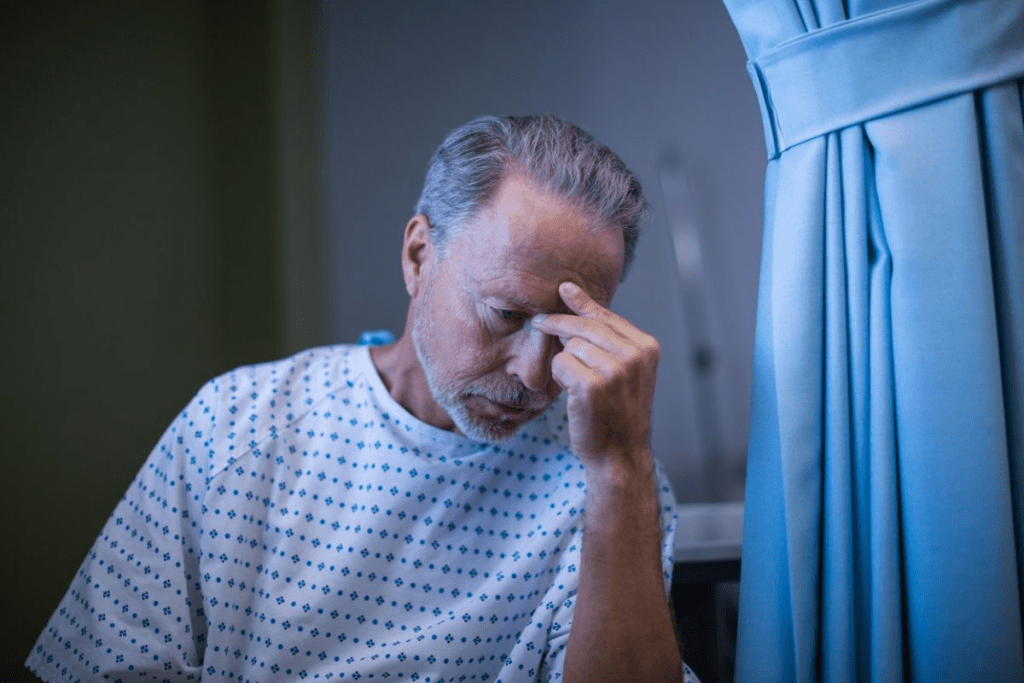Last Updated on October 31, 2025 by
Many men think prostate issues are only for older folks. But research shows symptoms and risks can start as early as 40.

Prostate cancer is rare for those under 40, but it can happen. In the USA, 10% of new cases are in men under 55. Men in their 40s should know about common problems like BPH, prostatitis, and prostate cancer risk factors.
The prostate gland is key to men’s health, becoming more important at 40. Knowing how it works and changes with age is vital.
The prostate is a small gland below the bladder, important for reproduction. It’s about the size of a walnut. Keeping it healthy is essential for normal functions.
Prostate health depends on age, genetics, and lifestyle. A healthy prostate is important for normal urination and sex.

By 40, the prostate might grow, leading to Benign Prostatic Hyperplasia (BPH). By 50, many men face symptoms like frequent urination and weak flow.
Changes in the prostate start in the 40s. It’s a key time for awareness and care. Knowing these changes helps men get medical help early.
Prostate problems grow more common with age. BPH and prostate cancer increase in men aged 40-50.
Knowing prostate cancer statistics by age and the average age for prostate cancer helps men stay proactive about their prostate health.
Middle-aged men often face various prostate conditions that can affect their quality of life. These issues range from mild to serious, needing prompt medical attention and treatment.
Benign Prostatic Hyperplasia (BPH) is a common issue for aging men. It’s estimated that BPH affects about 5-6% of men aged 40-64. BPH causes the prostate gland to grow, leading to symptoms like weak urine flow and frequent urination.
The exact cause of BPH is not known, but hormonal changes with aging are believed to play a role. As the prostate grows, it can block the urethra, causing urinary symptoms.

Prostatitis is inflammation of the prostate gland, a big worry for men under 50. It’s known that prostatitis affects about 8% of men at some point in their lifetime. There are different types, including acute bacterial prostatitis and chronic prostatitis/chronic pelvic pain syndrome.
Symptoms of prostatitis include pain in the groin and pelvic area, as well as urinary issues. In some cases, it can lead to infections that need antibiotic treatment.
Prostate infections, often linked to prostatitis, are common in middle-aged men. These infections can be bacterial or non-bacterial. Other non-cancerous conditions include prostatodynia, which is pain in the prostate area without infection or inflammation.
It’s important for men to understand these conditions to seek proper medical care. While BPH and prostatitis are common, knowing about other non-cancerous conditions helps in early detection and treatment. This improves overall prostate health.
Prostate cancer risk is tied to age, family history, and lifestyle. It’s rare in men under 40. Knowing these factors can help spot those at higher risk.
Prostate cancer risk grows with age, but it’s not common in the 40s. Studies show a big jump in rates after 50. Yet, some factors can raise the chance of getting it early.
Key statistics on prostate cancer incidence include:
Family history is a big risk factor for prostate cancer. Men with a first-degree relative (father or brother) diagnosed are at higher risk.
Genetic predisposition also plays a key role:
Lifestyle choices can up the risk of prostate cancer at a younger age. Obesity and physical inactivity are linked to higher risks.
Diet and lifestyle choices matter too. A diet heavy in processed meat and light on fruits and veggies can increase risk. Knowing this can help men make better health choices.
It’s important to spot prostate problems early. This helps in managing and treating them effectively. Prostate issues can show up in different ways. Knowing these signs helps men get medical help quickly.
Prostate cancer in its early stages often doesn’t show symptoms. This makes regular check-ups key. Some men might notice symptoms that seem like other health issues. These include weak or interrupted urine flow, frequent urination, and pain or burning during urination.
It’s key to tell apart symptoms linked to prostate issues from those of normal aging. Some urinary symptoms are common in older men. Yet, they shouldn’t be ignored and should be checked out.
As men get older, their urinary function might change. But not all urinary symptoms are just a part of aging. For example, Benign Prostatic Hyperplasia (BPH) can lead to big urinary problems like trouble starting to urinate, weak urine flow, and needing to urinate a lot.
Telling apart normal aging changes from symptoms needing medical help is vital. Men should see a doctor if they have ongoing or severe urinary issues.
Modern screening tools are key to catching prostate issues early. The digital rectal exam (DRE) and Prostate-Specific Antigen (PSA) test are often used. The PSA test checks for PSA levels in the blood. High levels can mean prostate cancer or other issues.
Regular screenings can spot prostate problems early, when they’re easier to treat. Men with a family history of prostate cancer or other risk factors should talk to their doctor about screening.
Finding the right treatment plan is key for men with prostate issues. Conditions like Benign Prostatic Hyperplasia (BPH), prostatitis, or prostate cancer need a custom approach. This ensures the best management and treatment.
Men with BPH or prostatitis have several treatment options. Doctors often prescribe alpha-blockers and 5-alpha-reductase inhibitors to help with symptoms. For bacterial infections, antibiotics might be needed.
Making lifestyle changes is also important. This includes eating right and staying active. These steps can help manage these conditions well.
Prostate cancer treatment depends on the cancer’s stage and how aggressive it is. Options include surgery, radiation therapy, and hormone therapy. For advanced cancer, treatments like targeted therapy and immunotherapy might be needed.
A healthcare provider will help choose the best treatment plan for you.
Liv Hospital has a detailed prostate care program. It covers diagnosis, treatment, and ongoing care for prostate issues. Their team works with patients to create personalized plans for the best results.
From the first visit to aftercare, Liv Hospital focuses on quality, patient-centered care.
Managing prostate conditions well needs a team effort. This includes medical treatments and lifestyle changes. Knowing your treatment options helps men make better choices for their health.
Prostate health is very important for men as they get older. Knowing the risks and taking action early can greatly improve life quality.
It’s key to know about prostate cancer, given the age-related statistics. Men should learn about the typical age for diagnosis and why early screening is vital.
Being aware and taking steps can lower the risk of prostate problems. Liv Hospital’s prostate care program shows the advanced care available for men’s health concerns.
Staying informed and getting medical help when needed is vital for prostate health. Men should focus on their health and talk to doctors about their risks and screening choices.
The risk of prostate cancer goes up with age. Men over 40 face a higher risk. The risk jumps up a lot after 50.
Prostate cancer comes from a mix of genes and lifestyle. Family history and certain lifestyles can up your risk.
Men usually get diagnosed with prostate cancer around 66. But it can happen to men as young as 40.
We don’t know all the causes of prostate cancer in young men. But genes, family history, and lifestyle play a part.
Signs of prostate problems include needing to pee a lot, weak urine, and painful pee. You might also feel pain or discomfort in your pelvic area.
Doctors use tests like PSA tests, DREs, and biopsies to find prostate cancer.
Treatments depend on the problem and how bad it is. They can include medicine, lifestyle changes, or more serious treatments like surgery or radiation.
Prostate cancer can hit men of any age. But it’s most common in men over 65. It can also be found in men as young as 40.
No, not every man will get prostate cancer. But the risk goes up with age. Family history and genes can also raise your risk.
Stats show that prostate cancer gets more common with age. Most cases are found in men over 65.
Subscribe to our e-newsletter to stay informed about the latest innovations in the world of health and exclusive offers!